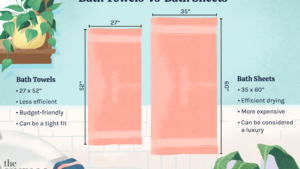How Long Should You Use the Same Bath Towel? Find Out!
An individual should ideally replace or clean their bath towel after every 3 to 4 uses, provided it has been properly dried in between uses.
Bath towels often collect dead skin cells and microorganisms during use. Even though a towel might appear clean to the naked eye, it could harbor bacteria or fungi that can provoke skin infections or other health problems.
Hence, regular washing of towels after every 3 to 4 uses is recommended to maintain hygienic conditions.
When you scrub your body with a bath towel, you are not just wiping off water; you are also rubbing off dead skin cells which can deposit on the towel. Moreover, towels often remain damp after use, providing an ideal environment for bacterial growth.
Hence, using the same towel for an extended period may lead to skin problems or other health hazards. Therefore, it is advisable to wash your towel regularly after 3 to 4 uses.

Key Takeaway
Factors To Consider
The duration of using the same bath towel depends on personal preference, cleanliness, and towel quality.
Regular washing and replacement every 1-2 weeks can maintain hygiene and ensure a fresh and functional towel.
When it comes to using the same bath towel, there are several factors to consider. The material and quality of the towel, the frequency of use, and the care and maintenance all play a role in determining how long you should keep using the same towel.
Let’s explore each of these factors in detail:
Material And Quality:
- The material of the towel is an important factor to consider. Different materials have varying levels of durability and absorbency.
- High-quality towels made from 100% cotton are often more durable and absorbent than those made from synthetic materials.
- Cotton towels also have the advantage of being soft and gentle on the skin, enhancing the overall bathing experience.
- Towels made from microfiber or bamboo blends are also popular choices due to their quick-drying properties and eco-friendly characteristics.
Frequency Of Use:
- How frequently you use your towel will impact its lifespan. If you use the same towel every day, it will wear out sooner compared to one that is used less frequently.
- It is generally recommended to rotate your towels so that each one gets enough time to dry thoroughly between uses.
- Using a fresh, clean towel not only ensures proper hygiene but also extends the lifespan of your towels.
Care And Maintenance:
- Proper care and maintenance are crucial in making your towels last longer.
- Always follow the care instructions provided by the manufacturer to avoid damaging the towel.
- Washing your towels in warm water with a mild detergent is usually recommended.
- Avoid using bleach or fabric softeners as they can affect the absorbency and durability of the towel.
- It is advisable to hang towels in a well-ventilated area to allow them to dry completely after each use.
The duration of time you can use the same bath towel depends on various factors such as the material and quality of the towel, frequency of use, and proper care and maintenance.
By considering these factors, you can ensure that your towels remain fresh, clean, and functional for an extended period.
So, make educated choices when it comes to your bath towels, and enjoy the comfort and luxury they provide.
Signs of Bath Towel Replacement
Odor and Mildew:
Over time, bath towels can develop a musty odor and may be prone to mildew growth. This can occur if towels are not allowed to dry properly between uses or if they are not laundered regularly.
If your towels persistently smell unpleasant even after washing, it may be a sign that they need replacement.
Visible Stains:
Stains on towels are not only unsightly but can also indicate a decline in their cleanliness. Despite regular washing, towels can accumulate stubborn stains that become harder to remove over time.
If you notice persistent discoloration or stains that do not respond to regular laundering, it might be time to consider replacing your towels for a fresher, cleaner look.
Decreased Absorbency:
Towels are designed to be absorbent, and their ability to soak up moisture diminishes over time with regular use and washing.
If you find that your towels are no longer effectively drying your body or hands, and instead feel damp or less absorbent than they used to be, this could be a clear indicator that the fibers are breaking down and it’s time for a replacement.
Signs of Wear and Tear:
Check for visible signs of wear and tear, such as frayed edges, thinning fabric, or areas where the towel feels rough.
Towels experience friction and stress with each use and wash, and over time, this wear and tear can compromise their overall quality.
If you notice the fabric is becoming thin or the edges are unraveling, it’s a sign that the towel has reached the end of its effective lifespan.
Regularly assessing your towels for these signs and being proactive about replacing them when necessary ensures that you maintain a hygienic and functional bath linen collection.
Keep in mind that the frequency of replacement may vary depending on factors like usage, laundering practices, and the quality of the towels. Investing in high-quality towels and following proper care instructions can extend their lifespan.
Hygiene And Health Considerations
Using the same bath towel for an extended period can compromise hygiene and health considerations.
Regularly changing towels is recommended to reduce the risk of bacteria growth and maintain personal cleanliness.
Bacteria and Mold Growth:
- Frequent use of the same bath towel can create an ideal environment for bacteria and mold to thrive.
- Damp towels provide moisture, warmth, and a food source for these microorganisms.
- Bacteria such as staphylococcus aureus and coliforms, as well as mold species like aspergillus and penicillium, can be present on towels.
- Using a towel repeatedly without washing it can lead to the accumulation of these harmful organisms.
Skin Irritation and Allergies:
- Bacteria and mold present on unwashed towels can cause skin irritation and allergies.
- These microorganisms can come in contact with your skin, leading to redness, itching, and rashes.
- People with sensitive skin or pre-existing skin conditions are particularly susceptible to these reactions.
- Regularly washing your bath towel helps remove these irritants and reduces the risk of skin problems.
Cross-contamination Risks:
- Using the same towel for different areas of your body can increase the chances of cross-contamination.
- Towels used for cleaning the face, for example, can transfer bacteria to other parts of the body.
- Sharing towels with household members or guests can also spread bacteria and other pathogens.
- To minimize these risks, it is best to use separate towels for different body parts and ensure regular washing.
To maintain good hygiene and prevent health issues, it is essential to consider these factors when deciding how long to use the same bath towel.
Regularly washing your towel, avoiding sharing towels, and using separate towels for different body parts can help minimize the risks associated with bacteria, mold, and cross-contamination.
Remember, your skin and overall health deserve the best care possible.
Best Practices For Prolonging Towel Lifespan
Discover the best practices for prolonging the lifespan of your bath towel, including tips on how long you should use the same towel to maintain optimum freshness and hygiene.
Proper Drying and Storage:
- After each use, hang your towel to dry completely. This prevents moisture from being trapped, reducing the risk of mold and mildew.
- Choose a well-ventilated area with good air circulation to store your towels, as damp and stagnant conditions can lead to unpleasant odors and bacterial growth.
- Avoid folding towels immediately after drying, as this can create creases that are harder to remove and may weaken the fibers over time.
Regular Washing and Sanitizing:
- Wash your towels regularly to remove dirt, oils, and bacteria that can accumulate with use.
- Follow the care instructions on the towel’s label to ensure proper washing. Use a gentle cycle, mild detergent, and avoid using bleach or fabric softener, as these can break down the fibers and reduce absorbency.
- Consider using a laundry sanitizer or adding vinegar to the rinse cycle to further eliminate bacteria and odors.
Rotation and Reserve Towels:
- Rotate your towels to evenly distribute wear and tear. Using the same towel repeatedly can lead to faster deterioration of the fabric.
- Keep a reserve set of towels for guests or special occasions to reduce the frequency of washing and extend the lifespan of your everyday towels.
- Avoid overloading your towel rack or hook, as excessive weight can strain the fabric and cause premature tearing.
By following these best practices, you can prolong the lifespan of your bath towels, ensuring they remain soft, absorbent, and hygienic for a longer period of time.
Remember, proper drying and storage, regular washing and sanitizing, and rotation and reserve towels will go a long way in maintaining the quality of your towels.
So go ahead, take care of your towels, and enjoy their comfort and functionality for years to come.
Conclusion
The question of how long you should use the same bath towel is ultimately subjective. While some experts suggest replacing towels every few days to prevent bacteria buildup, others argue that as long as the towel is properly washed and dried, it can be used for a longer period of time.
It’s essential to consider personal hygiene habits, towel care routine, and the overall condition of the towel.
Regular washing with hot water and a disinfecting detergent can help maintain cleanliness. Ensuring towels are well dried after each use can help prevent the growth of mold and bacteria.
Ultimately, the decision on when to replace a bath towel should be based on personal preference and comfort level.
By considering these factors, you can ensure that your towels stay fresh, clean, and hygienic for as long as possible.






